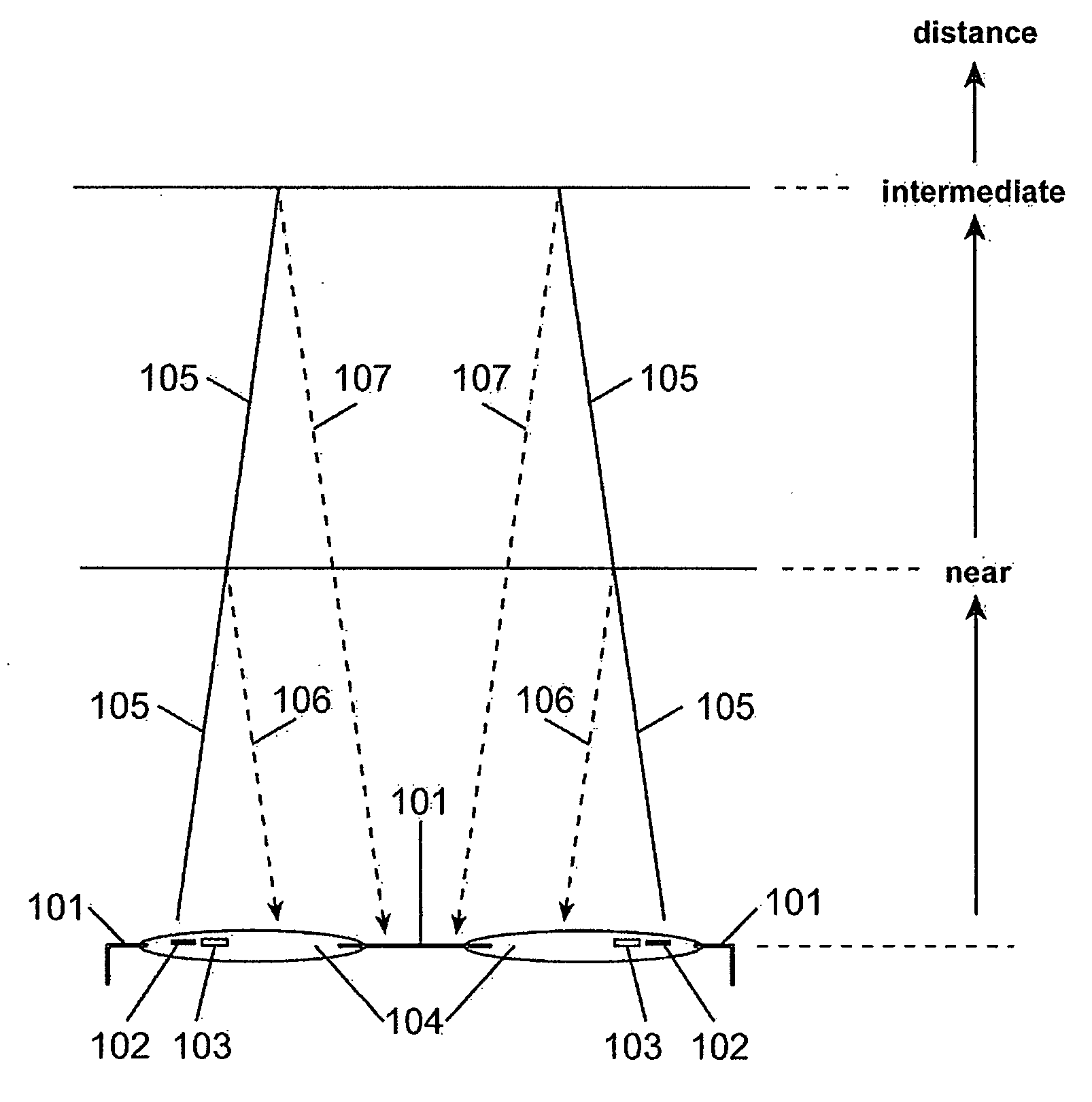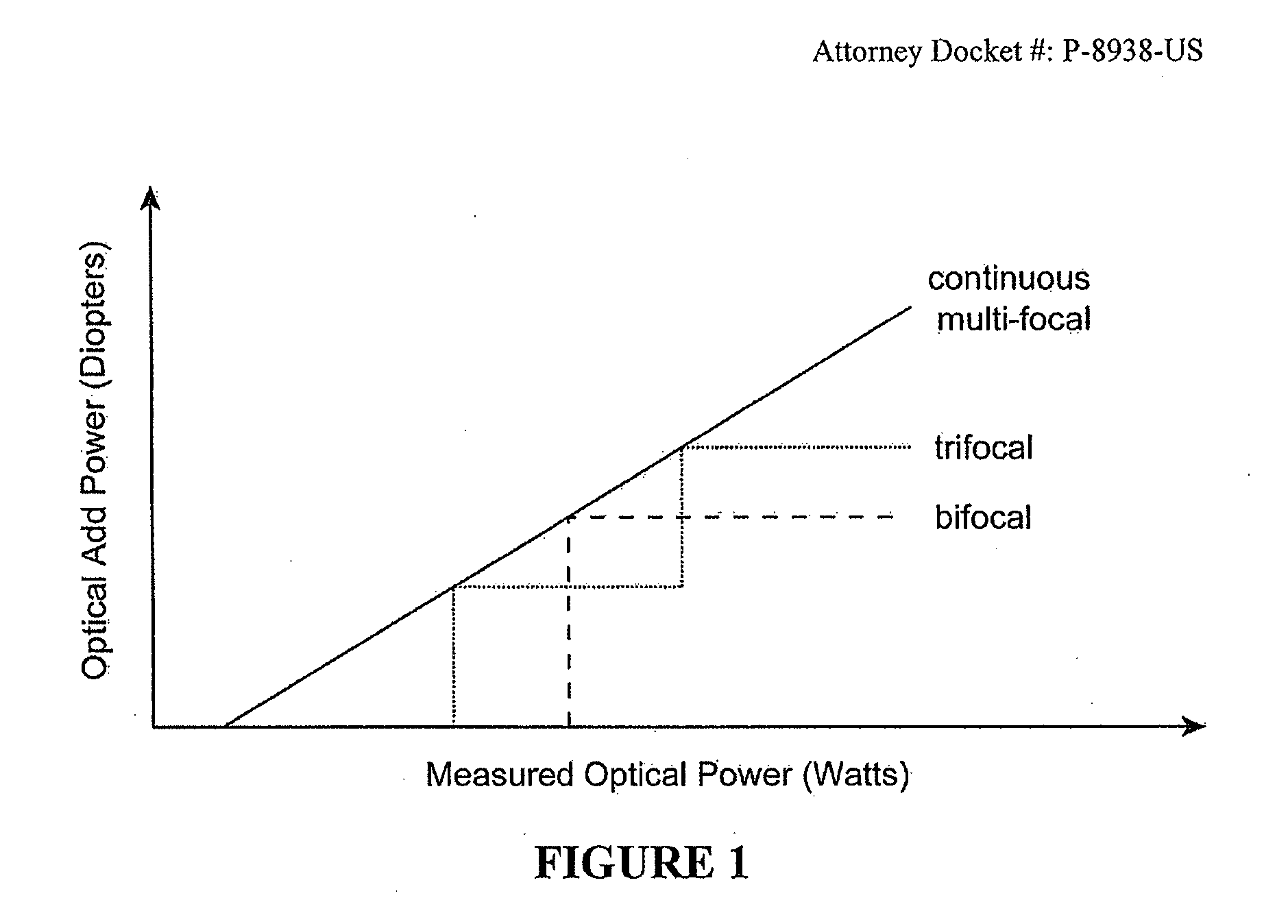Optical rangefinder for an electro-active lens
- Summary
- Abstract
- Description
- Claims
- Application Information
AI Technical Summary
Benefits of technology
Problems solved by technology
Method used
Image
Examples
first embodiment
[0044]In the invention shown in FIG. 2, a pair of electro-active spectacles 101 has a controller (not shown) connected to a range finding transmitter 102 and a range finding receiver 103. The transmitter and the receiver may be located near each other. A pair consisting of the transmitter and the receiver may be placed within a lens 104. To reduce specularly reflected light from reaching the receiver, a transmitted light 105 may be emitted at an angle such that a specular reflection from a near distance 106 and a specular reflection from an intermediate distance 107 may be directed away from the receiver. However, a diffuse reflection (not shown) may be received by the receiver. The controller may then use the diffuse reflection to determine a distance from an object to the user and apply an appropriate amount of optical power to the electro-active element such that the object is correctly focused. In the case where light transmitted from the transmitter of one lens is detected by t...
second embodiment
[0045]In the invention shown in FIG. 3, a pair of electro-active spectacles 201 has a controller (not shown) connected to a range finding transmitter 202 and a range finding receiver 203. The transmitter and the receiver may be located separately from each other. The transmitter may be placed within a lens 204 and the receiver may be placed within a frame 208. To reduce specularly reflected light from reaching the receiver a transmitted light 205 may be emitted at an angle such that a specular reflection from a near distance 206 and a specular reflection from an intermediate distance 207 may be redirected back to the transmitter and away from the receiver. However, a diffuse reflection (not shown) may be received by the receiver. The controller may then use the diffuse reflection to determine a distance from an object to the user and apply an appropriate amount of optical power to the electro-active element such that the object is correctly focused. In the case where light transmitt...
third embodiment
[0055]In the invention image contrast is determined by a mean square of derivative. The square of the local derivative can be estimated from either the nearest neighbors or next-nearest neighbors by the following estimator:
FM=Σi,jεΩΣk=−2:2,l=−2:2bk,l*(ai,j−ai+k,j+l)2 [0056]where bk,l are radially-decaying coefficients. This statistic may be most ready computed in digital circuitry.
[0057]The Focus Measure (FM) statistics from each image sensor array may be calculated by a controller. Although no requirement precludes the use of multiple statistics for each image sensor, power considerations likely limit how many statistics may be calculated for each sensor. The statistics computed for each sensor may then be compared. A statistic may be considered better than another if it is simply larger. Alternately, a statistic may only be considered better than another if it is larger by a threshold amount.
[0058]In an embodiment of the invention shown in FIG. 5, the range finding system may be c...
PUM
 Login to View More
Login to View More Abstract
Description
Claims
Application Information
 Login to View More
Login to View More - R&D
- Intellectual Property
- Life Sciences
- Materials
- Tech Scout
- Unparalleled Data Quality
- Higher Quality Content
- 60% Fewer Hallucinations
Browse by: Latest US Patents, China's latest patents, Technical Efficacy Thesaurus, Application Domain, Technology Topic, Popular Technical Reports.
© 2025 PatSnap. All rights reserved.Legal|Privacy policy|Modern Slavery Act Transparency Statement|Sitemap|About US| Contact US: help@patsnap.com



